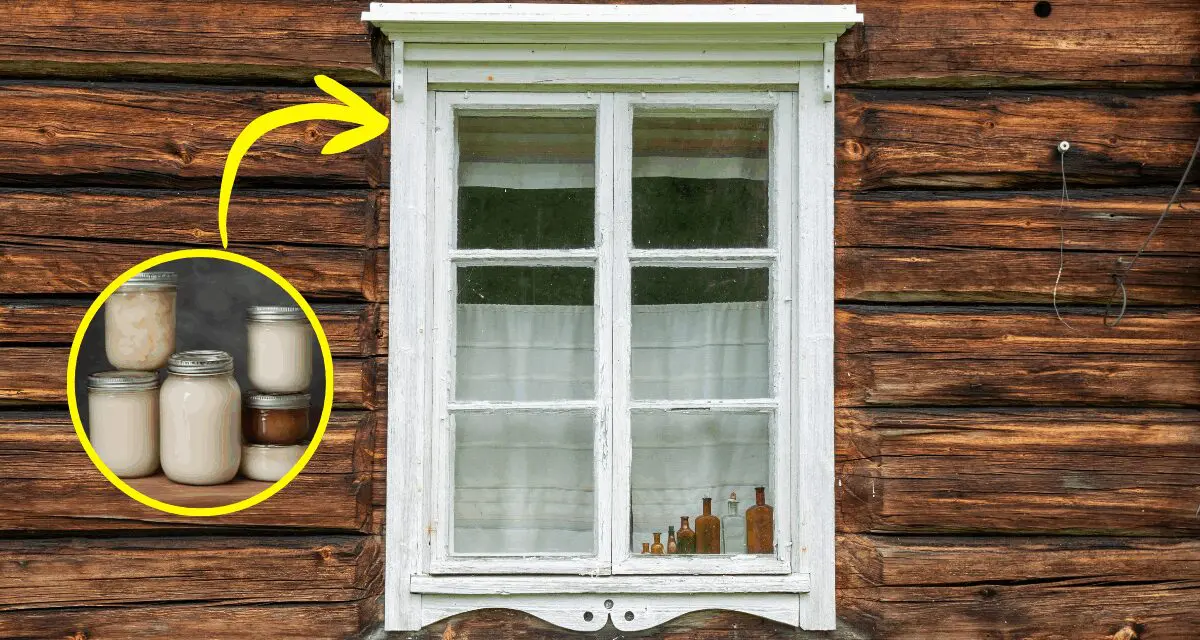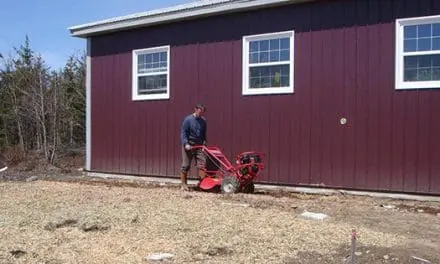You’re probably chuckling at the thought of smearing animal fat on your windows—and honestly, you should.
But this idea isn’t born from quirky folklore. It comes from centuries of hard-earned, practical wisdom.
The science is simple: lard is fat, and fat is a poor conductor of heat.
That means it slows the transfer of warmth.
In winter, heat from inside your home naturally rushes toward the colder air outside.
A thin layer of lard on the glass acts like an invisible blanket, slowing that escape and keeping your hard-earned warmth where it belongs—inside.
The Science and Survival Logic Behind Fat-Based Insulation
Lard’s insulating power lies in its very chemistry. As a lipid, it’s hydrophobic. It repels water, which happens to be one of the best carriers of heat.
By coating your window with lard, you’re laying down a thin shield of water-hating molecules that blocks moisture and stops the warm, humid indoor air from touching the cold glass. This prevents condensation (the sneaky process that drains heat from your home without you realizing it).
It’s a small, clever tweak to the physics of your living space.
Using animal fat this way isn’t a new trick—it’s a revival.
For thousands of years, people relied on rendered fat in oil lamps for light and warmth. The same qualities that made it a dependable fuel—dense, energy-rich, and slow to oxidize—also make it a powerful natural sealant and moisture barrier.
Back in the Great Depression, lard quite literally kept America alive. One particular dish made with it kept countless families from going hungry. It lasted nearly two years without refrigeration, and once the food was gone, the same lard was reused for cooking, making soap, or even treating burns.
When something that simple can keep you warm, fed, and prepared all at once, it’s hard to call it outdated.
>> Learn how to make the Great Depression food that saved America
By spreading lard on your windows, you’re tapping into the same principle: using the fat’s dense molecular structure and water resistance to create a tiny, heat-holding microclimate on your glass.
Step-by-Step Guide: How to Rub Lard on Your Windows the Right Way
To get started, you only need two things: a quantity of pure, rendered lard and a soft, clean cloth, like an old t-shirt or a piece of flannel.
Avoid using commercially processed lard from the grocery store if you can, as it often contains salt and preservatives that can leave residues on your glass; the best lard for this job is the kind you render yourself from pork fat.
Before you begin, ensure the window is clean and completely dry, because applying lard to a dirty or damp surface will trap grime and reduce the effectiveness of the insulation.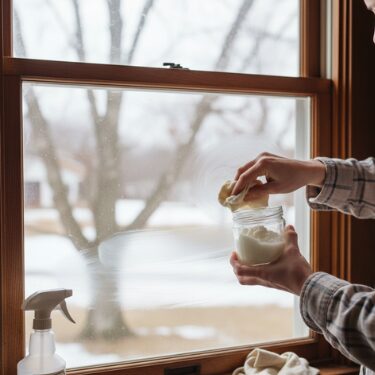
Start by taking a small amount of lard, about the size of a teaspoon, onto your cloth. You can always add more, but using too much from the outset creates a greasy, difficult-to-manage mess. Rub the lard directly onto the glass in a circular motion, covering the entire surface with a thin, even layer.
Your goal is to create a barely-there, translucent film, not a thick, opaque coating that will blur your view and attract dust. Pay extra attention to the edges of the pane and where the glass meets the frame, as these are the most common spots for drafts and condensation to form.
Once you have covered the glass, use a clean part of your cloth to gently buff the surface. This buffing action removes any excess grease and polishes the window to a near-invisible finish, which maximizes light transmission while maintaining the protective barrier.
If your lard is particularly hard, you may need to warm the jar slightly first to soften it for easier application. You should plan to reapply this treatment every four to six weeks throughout the heating season, or whenever you notice water beginning to bead up on the glass again. Always completely wipe off the old, dirty layer with a vinegar-and-water solution and dry the window thoroughly before applying a fresh coat.
Why Lard Beats Store-Bought Insulation in Off-Grid Living
The financial argument for using lard is straightforward and compelling. A single jar of homemade lard, which might cost you nothing if you process your own pork, can insulate every window in your home for an entire winter. Compare that to a box of window insulation film, which might run you twenty dollars or more and only covers a handful of windows.
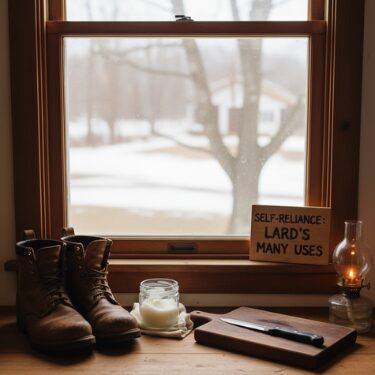
That plastic film creates a static-filled, crinkly barrier that often fails in high winds and generates plastic waste you must dispose of each spring. When you rub lard on your windows, you invest in a method that costs pennies per application and produces zero waste, aligning your budget with your principles of self-reliance.
Beyond cost, lard operates on a closed-loop system of sustainability that no commercial product can match. Its biodegradability means that when you wash it off in the spring, it introduces no harmful chemicals into your environment.
This same jar of fat that seals your windows also waterproofs leather boots, conditions wood cutting boards, and fuels your kitchen stove. Can a strip of synthetic rubber caulk or a plastic shrink-wrap kit make the same claim?
This multifunctional nature is critical for off-grid efficiency, where storage space is limited and every item you own should ideally serve multiple purposes.
You also gain a functional advantage over rigid sealants. Modern caulks can crack as your log walls or window frames expand and contract with seasonal humidity changes, breaking the seal and forcing you to redo the work.
Lard, however, remains flexible, continually adapting to these movements without losing its water-repelling integrity. It doubles as a natural waterproofing barrier that protects the wood of the window frame itself from moisture rot, a common problem that plastic films do nothing to prevent.
The Amish Way Of Using Lard
The Amish have been using fat to protect their homes for generations, and it’s clever in the simplest way. They smear lard or tallow along window edges and door frames, filling cracks and stopping cold drafts in their tracks. The same fat that blocks wind and moisture on glass is rubbed into wooden tools, door hinges, and leather harnesses, keeping them from swelling, cracking, or rotting in damp weather.
They even turn tallow into candles. A jar of melted tallow with a simple wick gives steady light and a little heat, enough to keep a room from freezing in a blackout or during a long winter night. The chemistry is the same as with window insulation: dense, water-repelling fat that holds energy and resists decay.
Basically, lard seals, protects, and preserves almost everything it touches. Windows, doors, tools, boots, even the wick in a candle, each use is a small survival edge. The Amish have been doing this for generations, and in a real off-grid emergency, there’s no reason you shouldn’t be doing it too.
If you want to see more of these off-grid home hacks straight from Amish traditions—from how they keep their homes ready for anything to how they get to live completely self-sufficient—The Amish Ways Book lays it all out. It’s actually written by a former Amish member, so it gives you firsthand, one-of-a-kind insights you won’t find anywhere else.
Inside, you’ll discover things like:
- How to build a backyard root cellar using only a trash can or barrel
- How to make an “Amish fridge” that keeps food cool with no power
- Forgotten foods that don’t need refrigeration and last for months
- Why the Amish store eggs in salt and beeswax instead of the fridge
- How to keep food safe in a well or stream when disaster strikes
Whether you’re preparing for economic collapse, an EMP, or just want to get off the grid, this book offers old-world wisdom that works in any crisis.
👨🌾Grab your copy using my personal 76% discount code right here (the offer will only be available for the next 2 hours 🕓)
Smart Homestead Hacks Using Leftover Lard
After you finish with your windows, that same jar of lard has only begun its work on your homestead. You can dip a rag into it and work the fat into dry, cracked leather on your work boots or harnesses, conditioning the material to repel water and prevent rot.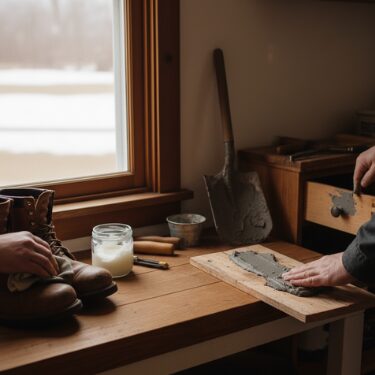
For a more substantial seal, warm the lard slightly until it becomes a liquid and carefully pour it along the seams of your tool shed door or the cracks in your chicken coop walls, where it will solidify and block drafts just as effectively as it does on glass.
If you encounter a stubborn wooden drawer that swells shut in summer humidity, rubbing a small amount of lard on the sticking wooden rails provides a slick, natural lubricant that doesn’t gum up like petroleum-based products.
You can also create a simple, effective weatherproofing paste for outdoor metal tools by mixing a handful of fine wood ash into a cup of melted lard; once cooled, this thick salve protects axe heads and shovel blades from rust when you apply a thin coat before storage.
For larger gaps in a workshop or barn wall, combine melted lard with lime or clay to form a pliable, temporary sealant that you can press into cracks with your fingers, a method that remains breathable and is easily dug out and replaced when necessary.
Creative Twists and Experiments Homesteaders Have Tried
If you find that plain lard is a bit too soft for your climate, you can easily modify its properties by blending it with other natural materials.
A common experiment involves melting one part lard with one part beeswax, which creates a firmer, more durable seal that holds up better in slightly warmer temperatures and has a pleasant, honey-like aroma.
For an even tougher, almost resin-like barrier, some homesteaders gently heat lard with a small amount of crushed pine resin, producing a sticky, waterproof compound that is exceptionally good at sealing drafts in moving parts like window sashes.
Another innovative twist involves using lard that was rendered from smoked pork.
The smoky compounds infused in the fat act as a mild deterrent to insects and other curious pests that might otherwise be attracted to the window seal. You can also create a reusable, physical barrier by applying a thin layer of lard to the window and then pressing a piece of clean, tight-weave cloth or parchment paper directly onto the greased surface.
This creates a primitive but effective “fat panel” that you can peel off and replace, combining the insulating power of lard with the added dead-air space of a sealed pocket, much like a primitive double-pane unit.
Inside A Navy SEAL’s Bug-In Guide, you’ll discover how to prepare your home and stockpile for survival in ways that make sense for off-grid living—keeping your food, heat, and essential supplies secure, safe, and ready when the grid goes down. You’ll start with a complete three-month stockpile you can eat from morning, lunch, and dinner, then build another for six months, and finally a full-year reserve.
You’ll see exactly where to buy these foods so they’re as affordable as possible, and you’ll get a day-by-day, meal-by-meal rationing plan to make sure you hit about 2,200 calories a day with the right balance of protein, fat, and nutrients to stay healthy long-term.
Besides what I’ve mentioned, here’s some of what you’ll find inside:
-
The Under $1 Walmart Canned Goods You Absolutely Need to Add to Your Food Reserves
-
A Meal in a Jar That Can Feed You for a Week
-
How to Make the Ultimate Survival Food with a 25-Year Shelf Life
-
The Only Seeds You Need to Stockpile for a Crisis
-
What Item You Should Remove from Your Pantry Immediately
-
How to Hide That You Still Have Power Left in a Blackout
-
What Great Depression Foods We’ll Be Eating Again Soon
-
How to Use a Car Battery to Power Up Your Radios
-
What Happens if You Take Expired Medications
And so much more!
The author printed only a limited batch of copies this time, and once they’re gone, they’re gone for good. You can access my personal discount right here!
How to Heat a Greenhouse Without Electricity
70+ Ingenious Projects To Help You Survive The Upcoming Economic Crisis (Video)
The Most Important Project You Need to Make This Winter on Your Property

